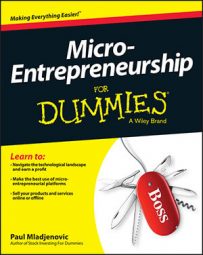For tax purposes, micro-entrepreneurs can deduct “ordinary and necessary” expenses incurred on behalf of their business. An ordinary expense is any expense common to a particular type of business. An ordinary expense for a trucking business, for example, is gasoline or highway tolls. A necessary expense is any expense necessary to operate a particular business. A necessary expense for a dentist, for example, is a license to practice dentistry.
In some cases, entrepreneurs in extraordinary cases have even asked the IRS directly and requested a letter confirming in advance as to the validity of the deduction.
Common tax-deductible micro-entrepreneurial business expenses
The following list of deductions is generally tax-deductible as business expenses:
Advertising and promotional costs
Business conferences and educational programs
Business publications (online and offline)
Business travel
Business use of telephone and other communication devices
Business use of auto
Computer software and business-related applications
Costs related to preparing business taxes
Internet connection costs and related Internet expenses
Office supplies
Payments to affiliates and resellers
Payments to independent contractors
Postage and shipping costs
Professional fees
Salaries, wages, and other compensation to employees
Small tools and office equipment used for your business
Supplies for creating arts and crafts for resale purposes
For more details on business expenses, go to IRS publication 535 (“Business Expenses”).
Depreciation of assets
Regular expenses (such as office supplies and business meals) are deducted (or written off) when they’re paid or incurred. You spend $150 for, say, advertising during 2012, and then you write off the full $150. But if you buy an asset for your business that can be used over a period of years, you depreciate it.
For example, if you purchase a used truck for $5,000 to deliver business goods, you depreciate (or take a deduction for depreciation expense) for five years, and deduct $1,000 per year over the five-year period.
Basically, you write off a portion of the truck expense for five years until you deduct the full amount. Business assets in different categories are deducted over different periods of time:
Three years, for computer equipment
Five years, for cars and small trucks
Longer periods of time, for factory equipment or business real estate
Check out IRS Publication 946 for more information.
Inventory and goods for resale
When you make or buy products for resale, you create inventory. This type of expense is in its own category because it’s considered an asset that you own that has future value (when you sell it).
For example, suppose you sell widgets, and that you bought 100 of them at $5 each (wholesale price) for a total cost of $500. Say that their retail price is $19 and you sell half of them (50 units).
For tax purposes, you basically have two options for reporting the sold items and the remaining inventory:
You can write off half of your purchase. This amount, or cost of goods sold, would be $250 (half of your sold items, 50 × $5. COGS is treated like an expense in your profit and loss statement. It’s also a deductible expense on your taxes.
You enter the remaining half that didn’t sell as inventory. Inventory is an asset that you have on hand.
For tax purposes, you can find some basic information on COGS in IRS Publication 334 Tax Guide for Small Business.
Business meals and entertainment
This is another special category of expenses. When you meet for a business purpose with prospects, clients, vendors, and so on, the cost of that meal and/or entertainment is usually tax-deductible with a 50-percent limit on how much you can actually deduct on your taxes.
Say you’re meeting with someone who is a potential client to discuss business during a meal. If that meal is $90, then the amount you can deduct is 50 percent, or $45.
Just having a receipt isn’t enough. To prove it was a business meal, you should attach more information to each receipt, such as:
Who did you meet and what was their status at the time of the meal?
For example, was the person a sales prospect, client, partner, vendor, supplier, and so on?
What business did you discuss?
For example, did you discuss marketing your product or service, meeting an existing client, and so on?
You can read more details on business meals and entertainment and how to document them in IRS Publication 463 Travel and Entertainment Expenses.
You also need to know a bit more about the business meals when looking to deduct them on your taxes. Business meals fall into one of two basic categories:
Local meals: They’re business meals you have in your local area and vicinity. For these, you follow the documentation guidelines discussed earlier.
Travel meals: When you’re on a business trip, the IRS considers meals in a slightly different manner. If you’re on a business trip (meaning you’re too far away to conduct business in a single day), then the IRS accepts just a receipt, because the documentation for the entire trip should indicate the business purpose.
In fact, the IRS can allow the deduction even without a receipt if you use the per diem method (expenses you may take during each day of business travel). The IRS assumes that, for example, you’ll have three meals while you’re traveling on business trips.
You can also find more details on this method in Publication 463.
Pension plan expenses
As a home-based business, you can set up a pension plan and deduct the contributions you make to it.
Consider creating a Simplified Employee Pension Individual Retirement Arrangement (SEP-IRA), and sock away up to $50,000 (the 2012 limit) per year. You can have a SEP-IRA in addition to your own 401k. You may also want to look into other options, such as a Keogh plan and other pension plans.
Learn more about small business pension plans with Publication 560 Retirement Plans for Small Business. The IRS also has a website on small business retirement plans called the IRS Retirement Plans Navigator.

